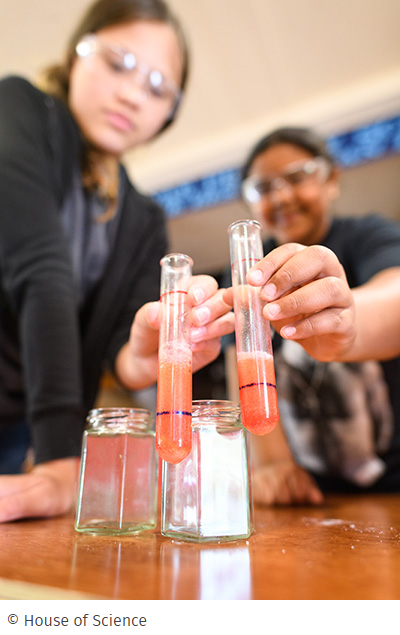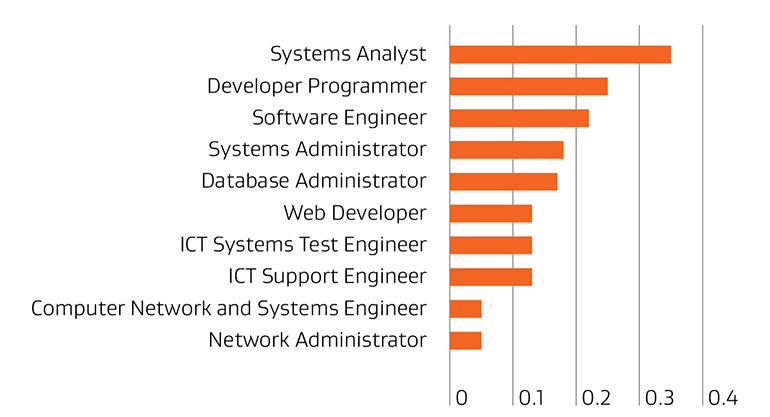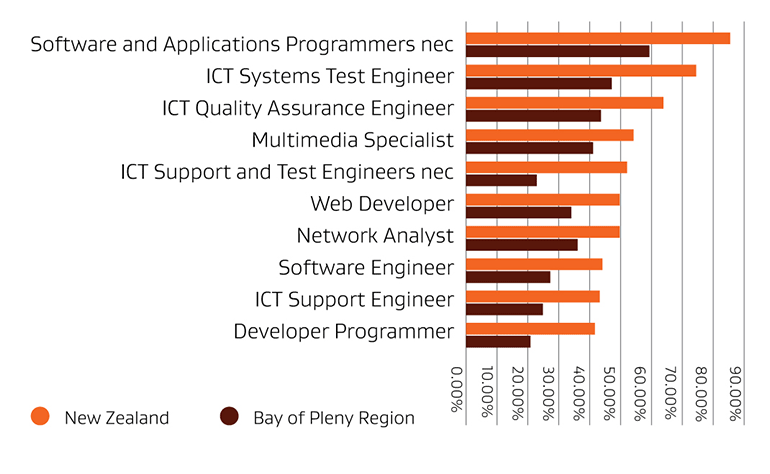Technology
On this page

Every person in the Bay of Plenty is digitally connected and enabled to participate in the region’s future workforce, including its growing knowledge economy.
The future workforce in the Bay of Plenty needs to be technology empowered and digitally connected irrespective of location or status. By providing accessible opportunities for rangatahi to be inspired and experience technology for themselves, and by supporting opportunities to develop, retain and attract advanced STEM capability, the Bay of Plenty will be a leader in providing a just transition for its people in our growing knowledge economy. Part of this will require thinking that intersects the already innovative approaches being used in-region and leveraging what rangatahi are already engaging in (e.g gaming).
Our approach
Digital technology is changing workforce and skills needs across the Bay of Plenty, whether through automation in packhouses and plants, businesses that are moving online, or start-ups in the growing technology sector.[17] [18] Nine out of ten people use a computer in everyday life, and even more (93%) are confident using digital technology to do their job.[19] However, increasingly jobs will need advanced digital skills.[20] The opportunity is to increase digital skills now, amongst rangatahi and in the existing workforce, to support both technology use, and ensure the sustainability of the Bay’s rapidly growing technology-led businesses.
The Group drew on local and regional knowledge, as well as national and global evidence and trends, to consider the role of digital technology skills in the workforce. They used the work of the New Zealand Digital Skills Forum[21] to define digital and advanced digital skills and found recent Te Pūkenga research into the aspirations of the region’s Māori learners insightful.[22] Regional educators, business owners and leaders generously participated in two wānanga focussed on building a digitally skilled BOP workforce.
Key insights
The Bay of Plenty’s future as a high-value, high-wage economy rests on its ability to leverage the innovation capability of its people and businesses. Māori have long been recognised as successful innovators and entrepreneurs yet are under-represented in STEM related education and employment, despite the region’s strong growth in technology-related businesses and employment. Regional tech employers such as Lawvu, RoboticsPlus, GPSit, PlantTech and Bluelab are actively planning for employment growth, and seeking to attract and develop their future workforce supported by growing tertiary provision (software engineering, geographic information systems (GIS)), and other enablers such as innovation and investor networks.[23] In-demand roles across the ICT sector include software developers, application and infrastructure support, and data science. This job growth is expected to accelerate as the Bay of Plenty further develops a niche in the agritech, advanced manufacturing, and tech start-up sectors.
Top 10 occupations in ICT 2021 (% total)

Graph description
However, the Group has discovered there is a crisis in science, technology, engineering, and maths (STEM)-related education participation across the Bay. Less than 2% of secondary school students currently enrol in STEM subjects or tech-related tertiary education, with curriculum, competency achievement[24], timetabling and a lack of information about employment pathways for rangatahi and whānau, all identified as barriers.[25] Inspiring more rangatahi into STEM study will be critical, as digital technology impacts almost every sector. Demand for advanced digital skills in jobs such as programming, data literacy, information security and deploying, managing digital hardware and networks, grows across all of the Bay’s industries. Currently, a high proportion of the Bay of Plenty technology workforce migrates to the region for the lifestyle, and while this pattern is expected to continue, the Group recognises the need to act now in growing the technological capability of local people so that they can actively participate in the region’s growing knowledge economy.
Growing digital and technology skills (and the corresponding increase in social capital) in the future workforce will also require continued effort to reduce the digital divide, particularly in the eastern Bay of Plenty where more than a quarter (28%) of the sub-region’s households do not have internet connections.[26] Many of these are low-income households and living in social housing.[27] Māori are over-represented in these households, meaning that whānau are more likely to be digitally excluded, and that children and rangatahi are disadvantaged in their learning.[28]
The Group has heard from business, iwi/Māori, local and hapori/community leaders tackling these issues. The Group will support them to amplify what is working, and to augment where more is needed, for example, through identifying and responding to future ICT industry job growth in the region.
Top 10 largest growth occupations for ICT professionals 2015 - 2021

Graph description
Case study: House of Science
There are a range of locally driven initiatives in the Bay of Plenty that provide rangatahi with STEM (Science, Technology, Engineering, Maths) experiences. House of Science (HoS) is one of these and is a local success story. Established in 2014, HoS provides STEM resource kits for primary and intermediate schools to raise scientific literacy. What started as a Tauranga initiative is now in 55% of schools across the Bay of Plenty including Western Bay of Plenty, Rotorua and the Eastern Bay as well as nationally with approximately 25% of all New Zealand schools accessing the extensive, bi-lingual science resource library.
Currently just 20% of students entering high school are achieving at the required curriculum level in science. This is largely due to the lack of confidence and resources of primary teachers. HoS empowers these teachers to deliver detailed, hands-on science lessons through a shared library of resource kits and teacher professional development.
Improving scientific literacy will have huge economic and social benefits to New Zealand. HoS is actively promoting and normalising science in primary classrooms which ensures all students have the skills and knowledge they need to benefit from new technologies and lift productivity through innovation.
The HoS programme reaches over 130,000 rangatahi, encouraging them to engage in STEM subjects. It’s their belief that by the age of 10, children have decided their career interests, so if they are not exposed to science at this age they are not likely to regain an interest it. Investment in the early years facilitates a transition into technology-related secondary and tertiary study so exposing children to science from a young age is an essential component to feeding the STEM career pipeline.
Technology action statements
- Grow digital technology skills and capability, particularly for rangatahi Māori, to transform the regional economy to one that is high value, and high income – improving prosperity for individuals, whānau/ family, and hapori/communities, throughout the region (through the following sub-actions):
- Inspire rangatahi to choose STEM subjects at school, and STEM tertiary education and employment pathways.
- Increase household internet access across the Bay of Plenty beginning with the Eastern Bay of Plenty, with a focus on households with tamariki and rangatahi.
- Grow workforce digital capability through increasing availability and access to tailored industry led, micro-credential training designed by employers and delivered in the workplace.
Footnotes
[17] Technological change and the future of work [PDF, 3.8MB](external link) — New Zealand Productivity Commission
[18] See for example: Resources(external link) — Better for Business
Bay of Plenty Regional Land Transport Plan 2021-31 [PDF, ; 4.4MB](external link) — Bay of Plenty Regional Council
[19] Technological change and the future of work [PDF, 3.8MB](external link) — New Zealand Productivity Commission
[20] New Zealand, technology and productivity: Technological change and the future of work, Draft report 1 [PDF, 2.7MB](external link) — New Zealand Productivity Commission
[21] Digital skills for a digital nation: An Analysis of the Digital Skills landscape of New Zealand [PDF 6.2MB](external link) — New Zealand Digital Skills Forum
[22] Te Rito: Insights from learners and staff – opportunities to enhance for all Te Pūkenga learners and Māori learners [PDF, 2.0MB](external link) — Te Pūkenga
[23] Subjects(external link) — The University of Waikato
[24] Educating New Zealand’s future workforce: Technological change and the future of work inquiry [PDF, 1.2MB](external link) — New Zealand Productivity Commission
[25] Educating New Zealand’s future workforce: Technological change and the future of work inquiry [PDF, 1.2MB](external link) — New Zealand Productivity Commission
[26] Report: Digital inclusion user insights — Māori(external link) — New Zealand Digital Government
[27] Digital inclusion in New Zealand: 2014 Survey of Adult Skills (PIAAC)(external link) — Education Counts
[28] Digital inclusion and wellbeing in New Zealand(external link) — Department of Internal Affairs

